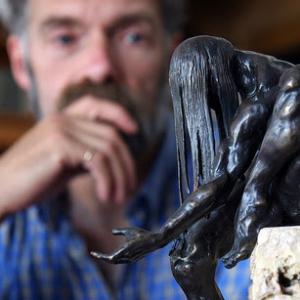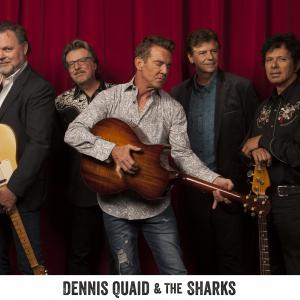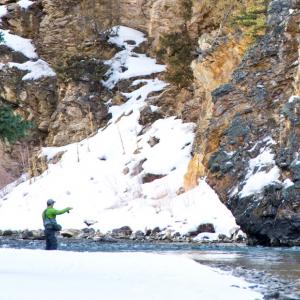Actor Dennis Quaid Goes ‘Out Of The Box’ On Debut LP
By Brian D’Ambrosio
Actor Dennis Quaid is sensitive to the uncertainty which surrounds the premise of a movie star releasing an album or even publicly picking up a guitar.
“I’m battling that (skepticism) and I understand that it’s natural,” said Dennis Quaid. “I’ve always said, come see the movie star and stay for the music. It’s been 18 years (history of Dennis Quaid and the Sharks), and I let that speak for itself. I make it (the live show) a theatrical experience for everyone, and get people out and moving…I know just where it (the suspension of disbelief) is going to come, and it’s usually in the middle of the show when people forget, and about the time we do the Doors, and people see what we are about. It’s about me opening up and owning it.”
Quaid lived in Montana’s Paradise Valley, a 60-mile stretch of land between Livingston and Yellowstone National Park, for around 25 years; after several years of listing, his 7,800-square-foot, three-bedroom rock-and-log ranch house sold in 2014. The state also served him well professionally when he captured Montana’s scenic and lush grandeur in the 1989 film “Everything That Rises.” Quaid made his directorial debut with this TV movie, a contemporary western with Quaid also credited as executive producer. Son of an electrician and a real estate agent Quaid made his acting debut in television in 1975. Yet most of his fondest childhood memories are tied to music not film.
“I wanted to do this (release an LP) even before I was an actor,” said Quaid. “I’m a late bloomer (at age 64). My earliest memory of music was Hank Williams and my dad was eclectic when it came to music. He loved Bing Crosby and Elvis (Presley) and he turned me on to Buddy Holly, Hank, Elvis, Eddy Arnold and Jim Reeves and the country scene…there was a record store in the mall about three blocks away from where I grew up in a suburb of Houston. There was a listening booth where you could listen to it before you bought it. The Beatles changed everything generationally and personally, and the single most influential album for me would be Waylon Jenning’s "Dreaming My Dreams"…another memory that stands out is being in the car in the backseat and hearing on KILT-FM radio that Buddy Holly died in a plane crash. He was 22-years-old and it spawned me listening to his music. It was the amount of songs and the sophistication of his songwriting and he was just starting to bloom in his life. Holly’s melody and lyrics defined what art was and lasted for another generation, and there was nothing similar before it.”
The state of Texas has produced enough diversity of music to be considered a law and a rank and a genre unto itself. As a high-school kid and college student, Quaid soaked up its rich history, discovering a steady stream of exciting venues and offbeat holes in the wall. Quaid said that in these exchanges that he experienced something he’d been seeking his whole life: freedom. It’s fomented an independence he’s embraced to this day.
”When I was at the University of Houston (’74), I’d go check out the black blues crowd and remember seeing B.B. King and other old blues artists who would come through, like Lightnin’ Hopkins… when I was 12 in Bandera, Texas, my dad took me to see Willie Nelson. He had short hair and big sideburns and in 1966 I got to see what started to happen in Austin. Joe Ely, Big Joe Walker, and Michael Martin Murphey. That got me to start writing and playing since I was 12.”
In 2000, the actor began singing and playing guitar and piano with his band, The Sharks, in between acting gigs. The realist in Quaid understands that the concept of creating something riveting or fresh in any artistic field is a brutal endeavor, so he’s waited almost two decades to release his debut LP. On “Outside the Box,” he explores new musical territory alongside the familiar.
“All art, whether its screenplays or music, or even Shakespeare struggled with the same problem, having influences. I hope it’s like osmosis, where it trickles down and you have to come out as you. Hopefully, you can write your own story. There is a personal element to songwriting and writing from your own experience, and it’s hard to get away from that. There is fictional truth, but it’s still personal, and hopefully the personal can be related to as universal through the sound and the lyrics.”
Quaid said that the immediacy and the affecting feedback of live music are what separate it from his previous work in television and film.
“It’s about trying to be in the moment and when you are on-stage you have that silent conversation with you and the other musicians, and the energy from the audience flows through and flows back to them.”
Quaid, who has achieved top-tier success as an actor in a variety of dramatic and comedic roles, said that he is humbled by the process of songwriting.
“I carry my guitar with me wherever I go and I’m never without it now,” said Quaid. “I’d like to learn how to make a craft of it and I can’t help but do it. I’ve got these musical phrases rolling around in my head – it could be that I hear or say something, like a title. It starts with a musical phrase and becomes a song, and the music and lyric feels the same to stimulate a feeling. Songs are personal. I try to hide them with a little bit of fiction, and I try to get the best out of the personal experience and also what’s most relatable to people.”
There is a precious and unique openness to songwriting that Quaid equates with humility.
“In the end as a songwriter, you want to relate to people and sometime it’s kind of embarrassing, yet necessary to make yourself vulnerable.”
The oldest song on the album, “Good Man, Bad Boy” was written around the time that Quaid portrayed rocker Jerry Lee Lewis in the 1989 film Great Balls of Fire!
“The majority of the (13) songs are mine and were written in the last couple of years, and I went on a tear. I had a lot to say and a lot to write about and I opened myself up to writing more personally, and not caring, and getting it out there. I wanted to make a record and do it for real, not just dabble in it. We are going to be the oldest guys to make it in music and we feel like teenagers with this first record, and we’ve got fire in our belly about it.”
Recorded at the Village Studios in Los Angeles, the album is filled with original songs by Quaid alongside covers of the Doors, Van Morrison, and Larry Williams. Quaid said that he had no anxiety about sharing and surrendering control of the album’s production.
“It is its own metamorphism. To take part in actually arranging them, and to hear them in my head in the beginning, and then on the road, and then to the audiences’ reaction. It’s Americana and a lot of rock n’ roll, blues, country, and lounge music. Genres don’t mean that much anymore since it (music) is not as regional as it used to be. The personal became collaborative and it (collaboration) grows the song, the overdubbing, and the editing, and the honing it into its real finality and locking it in…all records are of a particular time and moment, and that’s the way it is. Not having been listening to it for a few months, it closes a little distance and brings back the initial perspective, and it’ll be great to hear what other people think of it.”
The true method of knowledge and self-advancement is experimentation, and Quaid’s endeavor to spread and send out his long-standing love may be viewed independently as its own satisfying reward of experience.
“Music has always been the true girlfriend or mistress in my life,” said Quaid. “The guitar is something that I can talk to at anytime and it’s always been there for me. I can’t help but do it. Music is the universal language. It’s mathematical and the language of the spirit, and it don’t matter if you know the language or not.”
Quaid – who intends to return to the studio soon to cut another batch of songs, as well as stopover once again in Montana to present the recent bunch – said that he is not scared about standing exposed in a new medium. In fact he is making a commanding effort not to internalize any of the blunt skepticism that regularly accompanies the leaping of artistic avenues.
“I guess that I’m more tolerant of people these days, especially of myself,” said Quaid. “I don’t pay attention anymore to that little voice that says, ‘you are shit,’ or ‘you are not good enough.’ I watch what it says. But I try not to involve myself in it. By not listening to those judgments – my own and others’ – it leads me to not be so judgmental of the rest of the world.”




